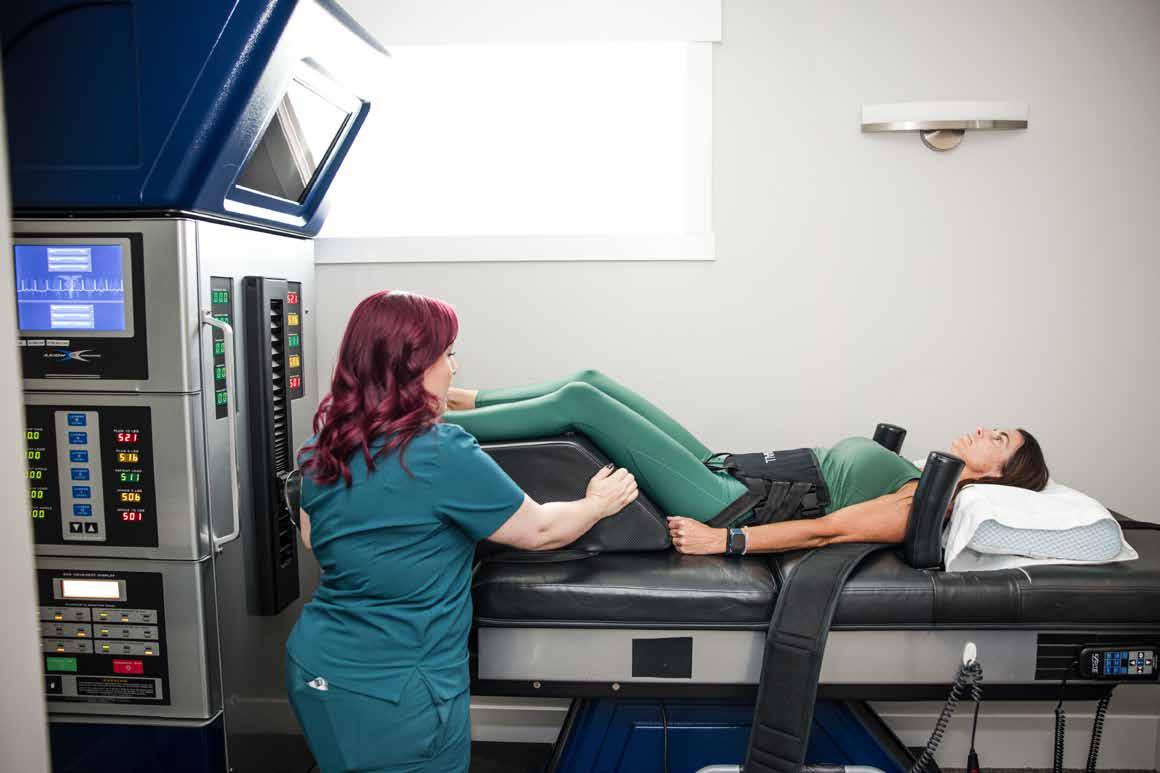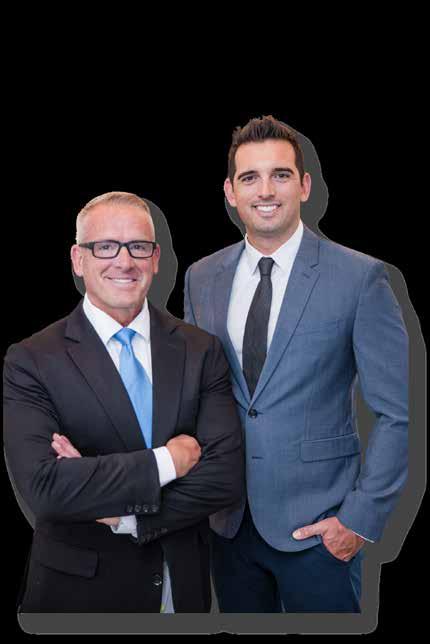














Because ‘music and passion are always the fashion,’ Barry Manilow shines the spotlight on dedicated RHS music teacher.
Riverton High School’s Director of Instrumental Music Jason Weimer shared the spotlight with Barry Manilow at the crooner’s concert at the Maverick Center July 14. Weimer, who teaches band, orchestra, winter color guard, marching band and AP music theory classes at RHS, was selected from eight local nominees as the winner of a Barry Manilow Music Teacher Award and $10K.
The Barry Manilow Music Project recognized one music educator in each community where the award-winning musician performed during the month of July. Weimer met Manilow and they spoke briefly about classical music, education philosophies and musical instruments, discovering that they both played the clarinet.
“Chatting with Barry was really cool,” Weimer said. “He’s really a kind person, or that was the kind of vibe I got.”
About halfway through his concert, Manilow asked the audience to applaud for Weimer, and many concert-goers approached Weimer after the show to congratulate him and to share personal stories of how much school music programs had mattered to them or their kids.
“That was super great, because public school teachers—it’s easy to get sort of discouraged sometimes—but it was super awesome and encouraging to see that many people come up to me and go out of their way to

50 count box!
American Heritage School
11100 S. Redwood Rd., S. Jordan Saturday, October 18th • 9am -2pm

say that it was important to them or made a big difference to them,” Weimer said.
RHS band parent Heather Ence was glad Weimer got the public recognition he deserves for being an excellent teacher.
“Weimer, as the students call him, did everything to make music fun and an enjoyable experience, and because of that, our son had a fantastic high school experience,” she said.
Weimer himself was shaped by his experience as a music student at Riverton High School. It was the influence of two RHS music teachers, Heather Christensen and Kevin Fallon, which inspired him to pursue a career as a music teacher. Weimer never left RHS— he worked on the marching band staff while attending college to earn a Bachelor of Music Education from the University of Utah and a master’s degree in Music Education from the University of Michigan. Then, just as he was finishing his degree, the teaching position at RHS became available.
“It was a serendipitous happenstance,” Weimer said. “Plus, it’s kind of every music teacher’s dream to work where they went.”
This will be Weimer’s thirteenth year of only $20 or 3 for $50 factory seconds
Continued page 4





September 25 | Alta View Hospital
October 2 | Riverton Hospital
October 7 | Intermountain Medical Center
October 9 | LDS Hospital
September 25 | Alta View Hospital
October 2 | Riverton Hospital
October 7 | Intermountain Medical Center
Join us for Ladies Night Out at Intermountain Health! We invite you to gather your friends for a night of fun just for the ladies. You’ll meet local providers, learn more about our services to empower you in healthcare decisions, taste delicious food and enjoy interactive activities.
Join us for Ladies Night Out at Intermountain Health! We invite you to gather your friends for a night of fun just for the ladies. You’ll meet local providers, learn more about our services to empower you in healthcare decisions, taste delicious food and enjoy interactive activities.
• Women’s heart health
• Women’s heart health
• Labor and delivery services
• Sports medicine programs
• Sports medicine programs
• Cancer care
• Pediatric care
• Labor and delivery services
• Pediatric care
• Mental health education
• Mental health education
• Cancer care
• Nutrition programs and healthy recipes
• Nutrition programs and healthy recipes
• And, many more medical specialities
• And, many more medical specialities
October 9 | LDS Hospital Scan the
Scan the

teaching music to high school students.
“One of the best things is witnessing the ‘a-ha’ moments or seeing kids fall in love with music or figure out something that they’ve had trouble with and overcoming those difficulties,” Weimer said.
Weimer hopes students learn to enjoy making music and that they continue throughout their lives, whether as a music professional or just as a hobby.
“If all they get out of it is to get [school] credit, then I feel like I didn’t do a good job,” he said.
Former student Abby Weseman, who is considering becoming a music teacher, said Weimer was a great role model as a kind and level-headed director.
“He really fosters an amazing culture in the music program and does a really amazing job of making sure that everyone feels welcome and happy in our music program at Riverton High,” Weseman said.
Band parent Amy Rushton said Weimer cultivates an environment of growth and inclusion that impacts students’ musical and personal development. Her daughter, Mackenzie, began as a timid violinist in Weimer’s orchestra and, with his encouragement, she worked to achieve concert master and also joined the marching band.
“He helped build up her confidence— she is more of an introverted, quiet person— and he put a lot of responsibility for her to grow and to develop her talents in areas that I don’t think she ever would have,” Rushton said. “As a mom, I just loved that he would find ways to connect with each student individually—because it wasn’t just her. He did it to all of them. He found ways to relate to the students.”
Over the 15 years Melinda Van Komen served as RHS’s marching band booster mom, she watched Weimer cultivate an atmosphere of real kindness with an emphasis on fun rather than perfection.
“One thing I really admire about him is he will take a kid who struggles with the physicality of marching band, and he knows that having that kid in formation, who can’t quite do it, is going to cost the band points in marching band [competitions],” Van Komen said. “But to Jason, winning is secondary—or not even secondary—it’s way down the list. But having a safe space for kids growing as musicians, growing as humans, and so many of those kinds of soft skills, are way more important to him than ever winning a competition.”
RHS Principal Rochelle Waite said Weimer advocates for his program and his students. She likes that his music programs develop students into good musicians as well as good people.
Waite is grateful to the Barry Manilow Music Project for recognizing music teachers, who she said don’t always get awards for the dedication and extra time they put into their jobs.
“I think sometimes we forget that, or we don’t focus on that enough when it comes to how much skill it does take to be involved and what hard work it is to be successful in a music program,” Waite said.
Both Waite and Weimer agree the music program’s success is due to an incredibly supportive community.
“I am incredibly grateful to work where I do,” Weimer said. “The community of Riverton is incredible— the teachers, admin and students make my job wonderful. But even more than that, my fellow directors make my life easier and my job even more enjoyable. I wouldn’t be successful without their efforts—Chris Jessee, Drew Holland, Taylor Ashcraft, Eric Perkins and Jillian Christensen.”
Half of Weimer’s award money will be spent to update the school’s band and orchestra instruments. The other $5,000, gifted directly to Weimer, will be used to take his wife to a nice dinner and then to make a large dent in his graduate school loans.l

The Riverton Journal is a monthly publication distributed directly to residents via the USPS as well as locations throughout Riverton.
For information about distribution please email hello@thecityjournals.com or call our offices. Rack locations are also available on our website.
The views and opinions expressed in display advertisements do not necessarily reflect or represent the views and opinions held by Loyal Perch Media or the City Journals. This publication may not be reproduced in whole or in part without the express written consent of the owner. © 2019 Loyal Perch Media, Inc.
Bryan Scott | bryan.s@thecityjournals.com
EDITOR
Travis Barton | travis.b@thecityjournals.com
ADVERTISING EXECUTIVES
Mieka Sawatzki | mieka.s@thecityjournals.com
Lindsay Andreasen | lindsay.a@thecityjournals.com
Jason Corbridge | jason.c@thecityjournals.com
Ryan Casper | ryan.c@thecityjournals.com
Marc Davis | marc.d@thecityjournals.com
Rack
Lydia Rice | lydia.r@thecityjournals.com 385-557-1022
Stacey LaMont Ty Gorton
9500 South 500 West, Suite 205 Sandy, UT 84070
PHONE: 801-254-5974

Prostate health may not be the most glamorous topic, but it’s a crucial one for men’s overall well-being. As men navigate their 40s, 50s, and beyond, understanding and prioritizing prostate health becomes increasingly important. This guide covers the essential things every guy needs to know about this small but vital gland’s role in male reproductive health.
As men age, the prostate can undergo changes, leading to various health concerns, including Benign Prostatic Hyperplasia (BPH), also known as an enlarged prostate, and Prostate Cancer.
Recognize the Symptoms – Don’t Ignore the Signs
Being aware of potential symptoms is crucial for early detection and management of prostate issues. Common symptoms to watch out for include:
• Frequent urination, especially at night
• Difficulty starting or stopping urination
• Weak urine stream
• Pain or burning during urination
• Blood in urine or semen
• Pain in the lower back, hips, or pelvis
“If you experience any of these symptoms, it’s essential to consult with your doctor. Regular prostate exams are vital, especially as you get older. Talk to your doctor about when you should start getting screened for prostate cancer. Screening typically involves a digital rectal exam (DRE) and a prostate-
specific antigen (PSA) blood test. Early detection significantly improves the chances of successful treatment for prostate cancer,” said Dr. Blake Johnson, a urologist at Holy Cross Hospital – Salt Lake.
BPH Treatment Options
The goal of BPH treatment is to alleviate symptoms and improve the quality of life. Treatment strategies vary based on the severity of symptoms.
For mild symptoms, lifestyle adjustments can be effective, including reducing fluid intake before bedtime, avoiding bladder irritants like caffeine and alcohol, following a healthy diet, and exercising, especially pelvic floor exercise.
Moderate symptoms often require medications that either relax the muscles in the prostate and bladder neck or shrink the prostate gland.
For more severe or persistent symptoms, minimally invasive procedures offer alternatives to traditional surgery.
• Prostate Artery Embolization (PAE):
This procedure involves blocking the blood supply to the enlarged areas of the prostate, causing it to shrink over time.
• Prostatic Urethral Lift (UroLift): Small implants are placed in the prostate to lift and hold the enlarged tissue away from the urethra.
• Water-induced thermotherapy: Uses heated water to remove the extra prostate tissue.
In severe cases, surgery may be necessary to remove part or all of the prostate.
Prostate Cancer Treatment
Prostate cancer treatment depends on several factors, including the stage and grade of the cancer, the patient’s age, overall health, and personal preferences.
“For low-risk prostate cancer that is slowgrowing and hasn’t spread, active surveillance may be recommended. This involves regular monitoring with PSA tests, digital rectal exams, imaging (for example MRIs) and possibly biopsies, without immediate treatment,” said Dr. Leland Rogers, radiation oncologist at Holy Cross Hospital – Jordan Valley Cancer Center. “If the cancer is more aggressive, we have several treatment options, including surgery, radiation treatment or hormone therapy.”
Surgery – Radical Prostatectomy: Surgical removal of the entire prostate gland and surrounding tissues. This can be done through an abdominal incision or laparoscopically, using smaller incisions and a camera.
Radiation Therapy:
• External Beam Radiation Therapy (EBRT), uses high-energy beams that are targeted at the prostate gland to destroy cancer cells.
• Brachytherapy where radioactive seeds are placed directly into the prostate gland to deliver radiation internally.
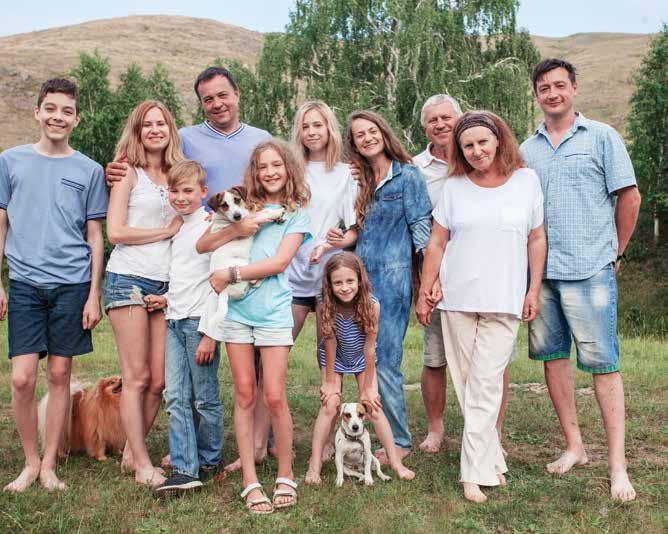
Hormone Therapy reduces the levels of male hormones like testosterone, which can fuel the growth of prostate cancer cells.
“Taking proactive steps to understand and care for your prostate health is an investment in your overall well-being,” Dr. Johnson said.
If you have concerns about your prostate health, schedule an appointment with a urologist by visiting www.mountain. commonspirit.org/care-and-health/urology. For all healthcare needs, schedule a consultation with a primary care physician or a specialist at mountain.commonspirit.org.

Learn more about the services, care providers and missiondriven work of the Holy Cross hospitals and CommonSpirit Health at www.holycrossutah.org.

At CommonSpirit Health, we make the healing presence of God known in our world by improving the health of the people we serve, especially those who are vulnerable, while we advance social justice for all.
Holy Cross Hospitals have been trusted by Utah families since 1875.
For 150 years, Holy Cross Hospitals have cared for Utah families in their most tender, powerful, and vulnerable moments. From newborn checkups to post-op recoveries, we’ve seen generations through their highest highs and hardest days.
We’ve done it all with one purpose: to treat people, not just patients. We care for every person with personalized treatment powered by compassion and respect.
Our belief that we all hold the power to heal helps us provide care that spans generations and stands the test of time.
Learn more at mountain.commonspirit.org/holycross150
your whole family tree.
60-year passion for softball honored by Utah Softball Hall of Fame.
By Shaun Delliskave s.delliskave@mycityjournals.com
I
f longevity were a stat in softball, John A. Copier would lead the league. He’s been playing the game since shag carpeting was cool, disco ruled the airwaves and nobody knew what a “streaming service” was. Now, after six decades of line drives and dugout banter, the 79-year-old Bluffdale resident is officially part of the Utah Softball Hall of Fame.
“I started playing softball right after Little League,” Copier (79) said, who grew up in Murray and now lives in Bluffdale. “First with church league and then County Rec. I’ve been playing ever since.”
Copier was honored Aug. 1 at the Larry H. Miller Cottonwood Complex, where he joined 22 other inductees including players, coaches, umpires and administrators. Of course, if a banquet is held on a softball diamond, they were going to provide food to match the occasion. “They gave us hot dogs, drinks—just an all-American thing. My family and some friends came out, and we had a good time.”
Born in Holland and the oldest of 12 children, Copier moved to Utah as a young boy. He credits his family for sparking his love of the game. “Six of my seven brothers and I all played County Rec ball at the same time—sometimes on different teams,” he said. “And my dad always showed up in his painter overalls, cheering us on.”
Over the decades, Copier played for a string of memorable teams, including Second Wind, Harper Material Han-

dling and Dodge Appliance Fast Pitch. “They were all good teams, full of wonderful people,” he said. “We had a lot of fun and made so many friends. That’s the best part of softball; you meet great people.”
Copier taught automotive at Skyline High School and Hunter High School, and even coached Skyline’s girls fastpitch softball team for several years.
Copier, and his wife of 43 years, Wanda, raised their kids Jon, Nathan and Amanda, and took up the softball lumber. “My kids supported me when I played, and I supported them when they played,” Copier said. His son Nathan even carried the family tradition overseas, playing in the UK and
making its European All-Star team. Now, Nathan is moving back to Utah, much to Copier’s delight.
As for the game itself, Copier has seen plenty of changes since the 1970s. “The biggest is the home run rule,” he explained. “You used to be able to hit as many as you wanted. Now it depends on your level—sometimes they don’t even let you hit one.” Safety features have also evolved. “There’s a safety base at first now and a separate home plate line to avoid collisions. They didn’t have those back in the day.”
Despite these changes, one thing has remained constant: Copier’s love for the sport. He has competed in tournaments across Utah and beyond, including the Huntsman World Senior Games, where he earned multiple medals. “We mostly played AA ball and a little AAA,” he said. “Lots of good experiences.”
When asked what advice he’d give to newcomers, Copier’s answer was simple: “Play. It’s a lot of fun. You get good exercise, meet great people, and sometimes even travel for tournaments. It’s been a huge part of my life.”
His wife Wanda added, “He’s made very special friends through softball. And most of his family played, too—it was just part of who we were.”
After six decades of swinging bats, sliding bases and collecting stories, Copier remains modest about his Hall of Fame induction. “Honestly, it’s just been fun,” he said. “Playing with my brothers, my kids, my friends—it’s been enjoyable all the way through. I never thought about awards. I just love the game.”
From church league to senior tournaments, John A. Copier has truly lived softball. And now, his name has a permanent home in the Utah Softball Hall of Fame; a fitting tribute to a lifetime spent on the diamond. l
Intermountain Health helps patients take proactive steps for their digestive health.
By Peri Kinder peri.k@thecityjournals.com
Asmore Americans pay attention to digestive health, Intermountain Health recently opened a free-standing endoscopy and surgical center in Sandy, located at Intermountain Health’s Alta View Hospital campus at 9450 S. 1300 East.
The American Cancer Society estimates that more than 100,000 new cases of colon cancer and nearly 47,000 cases of rectal cancer will be diagnosed in the United States this year. More than 50,000 Americans died from colon cancer in 2024, and doctors hope this facility will encourage more people to get screened for the disease.
“With the opening of our new endoscopy centers, Intermountain Health is increasing access to a lower-cost alternative for digestive health diagnostic and therapeutic procedures to prevent, identify and treat digestive health conditions in earlier stages,” Dr. Nathan Merriman said, senior medical director of the Surgical Specialties and Digestive Health Clinical Program at Intermountain Health. “This comes at a time when we’re seeing more people with chronic
digestive health conditions and younger ages of colon cancer across the U.S.”
Doctors recommend a colonoscopy screening beginning at 45, earlier if there’s a family history of colon cancer. Healthy eating, proper nutrition, improving gut health and maintaining a healthy weight can help lower the risk of colon cancer. This could mean limiting the amount of red meat consumed, eating fresh produce and whole grains and getting at least 30 minutes of exercise each day.
Intermountain Health professionals encourage patients to be proactive about their digestive health by talking with their doctors, getting screened and taking a team-based approach to a comprehensive health plan.
The free-standing endoscopy centers are more affordable because of lower overhead costs compared to operating under a hospital’s license. Patients are turning to this model of surgery center to keep out-of-pocket expenses for healthcare services down. The endoscopy center is a place that can help patients streamline their healthcare experience and no referral is needed for a screening colonoscopy at the Alta View Endoscopy Center.
Intermountain Health’s Riverton Hospital and McKay-Dee Hospital in Ogden will also open endoscopy centers. The Ogden facility will open later this year, while the Riverton location will open in 2026. The centers will be managed by Surgery Partners.

“This partnership is a great example of how we can bring innovative care models to life by working together,” Noah Clevenger said, Surgery Partners regional vice president of operations. “By aligning our strengths, we’re creating more access points for patients in Utah to receive timely, affordable and highly specialized digestive healthcare, while supporting physicians with the tools and environment they need to deliver exceptional outcomes.”
In addition to colonoscopies, the endoscopy center will provide upper endoscopy
procedures to examine the esophagus, stomach and upper part of the small intestine.
“[This will] help diagnose conditions like acid reflux, ulcers, swallowing difficulties, abdominal pain, bloating or nausea, chronic diarrhea, chronic constipation and hemorrhoids,” Merriman said. “These types of procedures can also aid in the diagnosis and treatment of chronic or more serious conditions like Crohn’s Disease, ulcerative colitis, diverticulitis or esophageal cancer.”
For more information, visit intermountainhealthcare.org.l
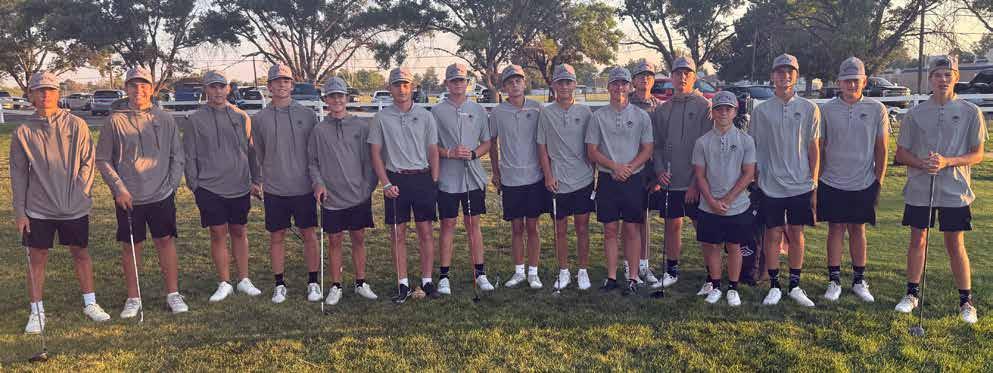
The Riverton boys golf team has a deep and talented group, ready to compete for region and state supremacy.
By Josh McFadden j.mcfadden@mycityjournals.com
Ayear after its highest finish in program history, the Riverton golf team is looking for even more in 2025.
The Silverwolves placed fifth in the Class 6A state tournament last season, the best mark since the school opened its doors. The competition will be challenging again this season, but head coach Kelly Pehrson sees no reason why Riverton can’t compete for the state crown.
“Last year, our team had the best season that Riverton High School has ever had,” Pehrson said. “We have most of that team back this year, with that same core team even stronger this year. So to be as humble as I can, our goal and expectation this year is to win 6A golf for the first time. I am confident in my boys. They have worked tirelessly for this, and it’s their time to shine.”
Pehrson is now in his fourth season with the team, meaning this year’s seniors were freshmen when he took over as head coach. It’s gratifying for him to work with players who have been with him for his entire Riverton career. He spoke glowingly of his senior class and the team as a whole. The players’ attitudes have been excellent, he said, and they get along well.
“I have been so excited for this season,” Pehrson said. “This senior class is
the group that I started coaching with four years ago. I have seen how hard they have worked for this and how their golf games have matured. They are a close group, and they have pushed each other to get better each year. The entire team has fed off this senior leadership. We have some amazing talent, not only with the seniors but with the underclassmen as well. It’s just an amazing group of kids that makes coaching so fun and easy.”
Leading the way for the Silverwolves is senior Jaxon Erickson, a standout golfer who has been the team’s top player since his freshman year. Erickson won’t end his competitive golf career once the season ends. He’ll continue playing at the collegiate level at the University of Utah.
“[Erickson’s] game, his attitude and his confidence are contagious to the rest of the team,” Pehrson said.
Four other seniors help lead the team and provide examples for the younger players. Pehrson said senior Boston Knight “works harder than anyone I have watched.” There’s also senior Warren Fisher, a vocal leader, who, according to Pehrson “is a very strong voice that the rest of the team listens to and follows.” Fellow seniors Kash Kimball and Trey Pehrson round out the 12th graders on the squad who have helped turn the program into a state contender.
“[Kimball] has played more rounds of golf this summer than ever,” Kelly Pehrson said. “Trey Pehrson is our silent but steady player who is peaking at the right time. This core group of seniors has created what every coach dreams of: an expectation and legacy for what talent there is at Riverton
High School.”
But there’s more to Riverton boys golf than the seniors.
Pehrson is grateful to coach a strong group of underclassmen. The juniors, sophomores and freshmen on the team bolster Riverton. They’re also proof that the future is bright for the program. Austin Bennion and Lincoln Judd were both in the top six last season. They were dedicated during the offseason to improving their game.
“They are not secret weapons anymore; these two have made names for themselves with how well they competed all summer,” Pehrson said of Bennion and Judd.
In addition, juniors Jackson Holt and Brevin Blake, as well as sophomores Cannon Smith and Hudson Boardman, are the most improved players on the team, Pehrson said. They will be working hard to make the six-player team that competes at the state tournament. Meanwhile, juniors Sebastian Dunaway and Koby Kerekes; sophomores Paden Newbold and Brock Curtis; and freshmen Mason Judd and Beckett Stewart are already making an impact and turning heads.
“Our newcomers that made the team this year fit right in with the rest of the team with their work ethic and passion for the game,” Pehrson said. “We kept 17 of the most talented players who will continue to set a precedent at Riverton High School.”
Riverton’s players haven’t struggled with their commitment. Pehrson said their work ethic has been outstanding. Combine this hard work with the players’ talent, and the Silverwolves could be a scary team
this season. If the players have confidence in themselves, Pehrson said that success should come.
“They need to trust their talent,” he said. “When I say they have worked tirelessly, I really mean it. They haven’t stopped practicing since last year’s season ended. They practice in simulators all winter, they play in 20-plus youth golf tournaments and just spend hours and hours on the driving range. For us to accomplish our goal, they need to play fearless and swing with confidence. Our motto this year is ‘All 18,’ meaning they need to be focused for all 18 holes of every tournament. If we do that, I know they will succeed.”
Perhaps the biggest challenge that Pehrson has is an issue that a lot of coaches would love to have: so many players. Unfortunately, Riverton won’t be able to take all the players to state, as only the top six qualify. Pehrson expects a lot of competition within the team to see who emerges with the lowest scores.
No matter where the team finishes this season, Pehrson is thrilled with the chance he has to coach this group and watch his players achieve their goals—on and off the golf course.
“I enjoy watching these boys become confident and good young men, not only in golf but whatever they choose to do,” he said. “I hope they know if they put in the time and energy like they have done in golf, in whatever they choose to do after high school, they will be successful. It is hard as a coach to see my players leave and move on with life, but I hope our program has shown them what hard work does and the possibilities that can open up for them.”l
Residents had the chance to meet first responders, learn safety tips and enjoy a night of activities
By Peri Kinder peri.k@thecityjournals.com
F
rom fire hose demonstrations to the arrival of an AirMed helicopter, Riverton’s Public Safety Night in early August offered activities and displays to engage and educate residents of all ages.
The annual event, held at Riverton City Park, drew hundreds of attendees to see the fire trucks and ambulance display, watch the K9 demonstration with K9 officer Atlas and his trainer Sgt. E.J. Estrada, talk with first responders from Unified Fire Authority and the Riverton Police Department and learn about emergency response and safe practices.
“We’re members of the community and we are your fire department,” UFA Captain Ben Sharer from Fire Station 124 said. “We like to come out and get to know
everybody, let people see what we’re capable of and then take the opportunity when we’re with the community to get a safety message out there and try to make everyone a little bit safer.”
Sharer said smoke alarms save lives, but wake the kids up because they often sleep through the noise. He also told parents to make sure kids know two ways out of each room and designate a central meeting place outside of the home in case of a fire.
The event featured a UFA gear demonstration, a SWAT display, a drunk goggles activity, plus information booths for animal control and emergency preparedness.
RPD Chief Shane Taylor said it’s important for the department to be transparent in what they do, and this event helps create communication between officers and residents. He said his number one safety tip would be common courtesy.
“Be considerate,” Taylor said. “I think common courtesy has kind of gone on the wayside. I think if we respect each other and treat everybody the way we’d like to be treated, I think it would resolve a lot of problems.” l



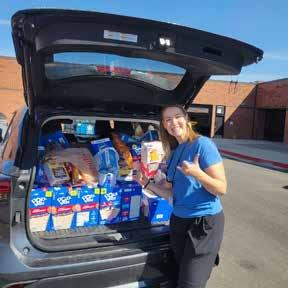



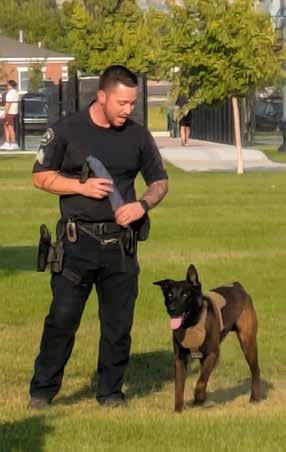


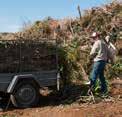





























By Peri Kinder | peri.k@thecityjournals.com
If you’ve ever wondered if your dog is happy, your lizard is upset or your bird is mad at you, Jennafer Martin could help you find the answer. Martin is a pet psychic with years of experience communicating with animals, getting to the root of what’s bothering your furry, feathery or scaly pet.
By tapping into an animal’s emotions, Martin offers insight into their behaviors, fears and level of contentment. She first realized she could communicate with pets when she received a Teddy Bear Hamster for her 14th birthday.
“For three days, she was happy, playful and delightful, but on the fourth day, I felt she was sad,” Martin said. “She wasn’t sighing heavily, or anything like that, I just felt like she wasn’t happy…Two days later, she had 13 babies. I would think if you’re gestating 13 of anything, you wouldn’t be very happy.”
It was the first time she realized she could pick up on things other people couldn’t. It was easy for her to read the emotions of the animals and share that insight as a way to create better understanding between humans and pets.
Martin had been a tarot reader and energy worker for several years before she decided to become a professional pet psychic in 2013.
“Even if I’m reading for animals, I’m still reading for people, so they understand how interesting their animals are,” she said. “I’ve read for reptiles, rodents, fish and large animals like ostriches and horses.”
Whether it’s decoding a bird’s persistent squawking or helping a rescue dog settle into a new home, Martin said her work bridges the gap between human and animal hearts.
Most animals have the mental capacity of a 2- to 5-year-old and she doesn’t receive fully-formed guidance from the
pets. Instead, she feels their emotions, sees images or has an intuitive sense about what’s going on in the pet’s mind.
While reading for a French Bulldog, Martin said the dog kept sending her an image of something orange and puffy, and the dog didn’t like it. The owners couldn’t think of any blanket or clothing item that would cause her such annoyance until they remembered a Halloween costume from the previous year. They’d dressed her as Nemo, from “Finding Nemo,” made with orange, puffy fabric. Martin had picked up on the dog’s irritation with the costume, which the owners promised never to use again.
Holly Esch regularly reaches out to Martin for help with her six lizards and she believes it’s kept them healthy and happy. After her lizard’s partner died, Esch asked Martin how her lizard was coping with the loss and if he was open to meeting another lizard. When Esch was trying to hatch lizard eggs, she asked Martin to do Reiki energy work to keep them from dying off.
“I ask relationship questions about them because they’re kind of like humans,” Esch said. “They bicker, they fall in love, they have their own little dramas and they have their own little different personalities. [Martin] just knows a lot of things and offers another perspective.”
When a family’s rescue tortoise kept trying to escape, Martin let them know he was looking for a mate. She discovered why an anxious cat had stopped using its litter box and why a puppy wouldn’t use the bathroom outside if he was alone. When Martin’s sister had a cat dying from cancer, Martin let her know when it was time to relieve its suffering.
Martin is often met with skepticism and is sometimes “tested” by pet owners when she’s asked to work with an animal, but she’s fine with that. She said it’s not her job to convince anyone that what

she’s doing is real.
“It’s fine to come with a sense of curiosity or a sense of skepticism,” she said. “At the end of the day, hopefully you know a little bit more about why your pet thinks or feels or behaves the way they do. You don’t have to buy in on what I do, as long as you resonate with the message that I give.”
Animals don’t always see the world the way humans do. Martin hopes her ability to communicate with pets helps owners become more patient and un-
derstanding with “naughty” behavior, especially when the animal is trying to be heard.
“I’d say 90% of the time, they’re not trying to be difficult. They’re just trying to get their needs met,” Martin said. “Sometimes, they’re just a little misguided or misunderstood…If you understand your animal better, then you feel like you can take care of them better, and then everybody’s happy.”
To schedule an appointment with Martin, visit readingsmorebyjennafer.com.
By Shaun Delliskave | s.delliskave@mycityjournals.com
Sixty-five years after opening its first shelter in a modest West Valley City facility, the Humane Society of Utah marked its journey from humble beginnings to becoming the state’s largest open-admission animal resource center. The nonprofit celebrated its anniversary with a free community birthday party at its Murray location on Saturday, July 12.
“We are throwing a fun-filled all ages welcome birthday party!” the organization stated in a press release prior to the event. “Enjoy activities such as a bounce house, carnival games, face painting, balloon art, and more.”
Founded in 1960, HSU has operated as an independent 501(c)(3) nonprofit funded entirely through donations, without government or state support. Its mission has remained consistent for more than six decades: to protect and improve the lives of animals across Utah.
“This summer, the Humane Society of Utah is thrilled to celebrate 65 years of saving pets and supporting families in Utah,” the release stated. “As we celebrate this special birthday, we reflect on how far we have come, and the generous community support that made this milestone possible.”
HSU opened its first facility in West
Valley City before relocating in 1992 to its current Murray site, the Janice R. Johnson Center for Animals, funded by a request from Utah schoolteacher Janice Johnson. The larger building allowed the organization to expand its services and later add specialized adoption areas, including Kitty City, Bunny Bungalows, Dawgville, Tiny Town, and Critter Country.
“In 1972, HSU opened the first low-cost spay/neuter clinic in the Intermountain West,” the release noted. “This essential milestone helped to prevent overpopulation in the area, and gave countless pets the chance for a healthier, happier life.”
The Murray facility also continued to offer a range of services through its integrated clinic, including low-cost spay/ neuter surgeries, vaccinations, microchipping, wellness exams, and heartworm testing. Specialized programs such as CATNIP, a community cat spay/neuter and trap initiative, and SNIP, a spay/ neuter incentive program for pet owners experiencing financial hardship, were developed to address specific needs.
In 2020, HSU opened a second clinic in St. George to expand access to affordable veterinary care in southern Utah. In 2024, wellness exams were added to its

Murray clinic offerings. “These preventative care services are vital to protecting pet health and wellness,” HSU stated. “They allow pets and families to enjoy longer, healthier years together.”
In 2023 alone, HSU reported placing 5,529 homeless animals into new homes and assisting approximately 1,189 community-owned pets through its retention and diversion programs. The organization emphasized an education-focused adoption process and a policy of no time limits for healthy or treatable pets awaiting adoption.
Staffing included 53 full-time employees and numerous volunteers. Community engagement extended through adoption events, humane education, foster programs, rescue and transfer initiatives, and legislative advocacy efforts aimed at preventing animal cruelty and addressing the root causes of pet homelessness.
“Donations from our caring community have been the backbone of every expansion, every new program, and every life-saving effort over the years,” the release stated. “It is inspiring to see how our community has stepped up to the plate, generously giving love and hope to local pets in their time of need.”
As part of its anniversary message, HSU highlighted plans to modernize its facilities and expand collaboration with other organizations. “Caring for pets does not exist in a vacuum. Protecting vulnerable pets begins with supporting our human neighbors,” the release said.
While reflecting on its past, HSU also
pointed to the future. “We have accomplished so much together in 65 years,” the organization stated. “We cannot wait to see what the next 65 years will bring for pets and families in Utah.”
For more information on the Humane Society of Utah’s programs, adoption services, or volunteer opportunities, visit utahhumane.org.

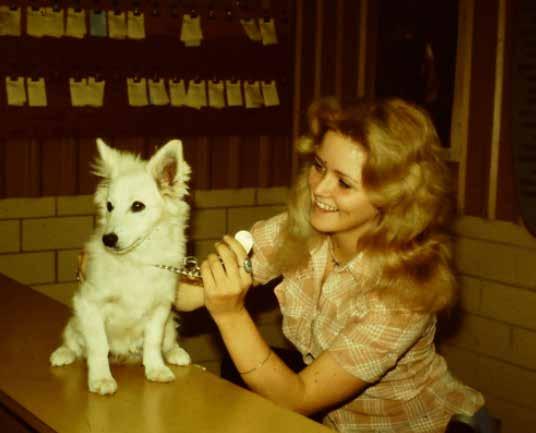
By Tom Haraldsen | t.haraldsen@mycityjournals.com
Temma Martin’s personalized license plate reads “PETLADY.” As it should. For nearly 30 years, she has been the voice for pet protection in Utah, both before and after they’re born. Her latest efforts are part of the new nonprofit she has founded and created, “Operation Pawpulation” in Millcreek.
The clinic focuses on spay/neuter services, coming at a time when the numbers of dogs and cats in animal shelters have been increasing. She has championed adoption for decades, but has turned her efforts into prevention of unplanned litters for dogs and cats. Martin first became involved in this world while she was in college, concerned about animal welfare but not really thinking it would become her career.
“I didn’t start in any other area or direction,” she said. “When I was finishing my senior year of high school in Colorado, I got a little bit involved with animal rights stuff, like protesting research labs and more like actual animal rights than animal welfare. So I was sort of interested then, but when I moved back here, I worked at several businesses. When I worked at Golden Swirl’s corporate office, I saw an ad in the paper for a job posted at the Humane Society of Utah in 1993 for an education director.”
She worked for them for four years but felt she wanted to do more public relations, so after a short stint with the American Heart Association, she became media specialist for Salt Lake County Animal Services.
In that role, Martin appeared on every local TV morning program — news or lifestyle shows — bringing dogs or cats on air who were waiting for adoption from the shelter. She brought on an estimated 5,000 animals over her career, and her name and face became synonymous with pet adoption in the Salt Lake market. It often meant going to the shelter in very early morning
hours, waking up a pet to take them to a station, and all four local TV stations had segments with her regularly.
A countywide reduction of force led to her leaving the post in 2008. She was quickly approached by the Utah Animal Adoption Center, where she worked for one year, then joined Best Friends Animal Society.
Her messages about pet adoption helped. When the No More Homeless Pets coalition started in 1999, Utah shelters were alarmingly still killing almost 40,000 pets a year. But by 2020, with more and more no-kill shelters coming online, that number had fallen to 829.
Good news, with numbers headed in the right direction toward making Utah a no-kill state. Then COVID arrived, and things changed. Today, an average of 2,000 dogs and cats are euthanized in Utah.
“The numbers of animals killed has steadily increased, not just in Utah, but across the country,” she said. “People are watching what feels like a pretty major backsliding of progress, and some of the reasons for that are there’s a shortage of veterinarians. A lot of veterinary clinics are being bought out by corporations and private equity firms, and prices of all veterinary care have risen at a rate much higher than the rate of inflation.”
Two years ago, she left Best Friends to start her own nonprofit using her own money. She bought a storefront in Millcreek that was once a boat repair shop to create a clinic offering spay/neuter services to pet owners at very reduced costs, a service that she says has “gotten outrageously expensive in a lot of places.” She said the universe had something else in mind for her.
“I made some phone calls to clinics in Salt Lake County, and some of them are places I either am or have been a client,” Martin said. “A cat neuter is the lowest. They’re the least expensive and quick-

est surgery. And so on the low end, I believe it was just less than $300 for a cat, but on the high end, for a large dog spay, one clinic said that it could be more than $2,000. Most people can’t afford that — it’s a mortgage payment, a rent payment. So for a lot of people it’s out of reach. And for some reason, even nationally, a lot of animal welfare organizations have shifted their focus away from spay/neuter, which is largely why I felt like I needed to go off on my own.”
Shelter Animals Count, a trusted source for animal sheltering data, has reported that 28% of the 2.9 million dogs entering shelters in the U.S. were puppies under 5 months old. That was an increase of more than 31,000 from the year before. More than half of the felines entering shelters were under five months old as well — 1.7 million.
“We can’t solve this problem after all the pets are born,” she said. “There will always be people who choose to buy pets, but there are so many pets in need outside of shelters. The only way we can get back on track is getting pets spayed or neutered and prevent the downstream that creates animals in need.”
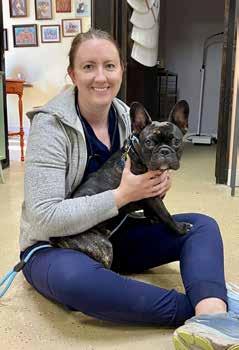
Operation Pawpulation is open on Thursdays. Call 801-509-8334 to set up an appointment or get more information.


By Peri Kinder | peri.k@thecityjournals.com
Join Salt Lake County Animal Services for a celebration of our furry family members at Petapalooza. This free, family-friendly event turns Wheeler Historic Farm into a haven for animal enthusiasts with pet adoptions, free microchips for licensed pets, food trucks and local pet-friendly vendors.
The two-day event will host hundreds of adoptable dogs, cats and small animals from local rescues and shelters. Friday’s experience is mostly for pet adoption, while Saturday features a full range of activities.
Guests can get a photo of their pet, talk with dozens of vendors dedicated to helping animals and visit with pet psychic Jennafer Martin for insight into their pet’s emotions and health.
“This event helps clear out not only the shelter and rescues, but also allows more eyeballs on these pets, even if people are not looking for a pet,” said Ashley Bales, Salt Lake County Animal Services communications coordinator. “People show up and support what we do. They visit the vendors, too, because typically these vendors are in the local communities. They’re local businesses, small businesses and family businesses.”
Attendees can also donate to Salt
Lake County Animal Services and learn about No-Kill Utah, an initiative led by Best Friends to end the killing of animals in Utah shelters. Learn more about animal services at saltlakecounty.gov/animal-services.
Petapalooza will be held at Wheeler Historic Farm (6351 S. 900 East) on Friday, Sept. 12 (3-7 p.m.) and Saturday, Sept. 13 (9 a.m. - 4 p.m.). The event is sponsored by Salt Lake County Animal Services and No-Kill Utah.
“Our photographer will also be there,” Bales said. “Once a month, she goes into the shelter and donates her time to do photos for all of our dogs. It’s proven that shelter dogs with a better photo have a higher adoption rate. So she volunteers her time, and she’s been doing it for like 10 years. It’s great to have her at the event to do photos for dogs in the community.”

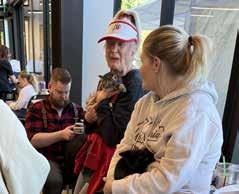

Summit Veterinary Urgent Care was founded in October 2024 by Dr. Taylor Howard (DVM) & Cassie Czerny (CVT). We o er expert, walk-in emergency services for pets in the Salt Lake Valley. We provide immediate, compassionate care when your pet needs urgent attention— no appointment necessary.
What products and services do you o er?
We provide walk-in and same-day appointments, especially for situations that need immediate attention. We also o er
medical transportation for those who have limitations, like a small vehicle or a large dog. For pets recovering from surgery, or needing to be transferred to an overnight facility, we are wellequipped to help our clients.
What else do you provide?
We have in-house medication and an online pharmacy to ensure your pet gets treated quickly. We do on-site laboratory diagnostics, including advanced imaging with state-of-the-art ultrasounds and radiology. Our fully equipped surgical suite at Summit Veterinary is designed to provide advanced surgical care in a clean, comfortable, and sterile environment.

What sets your company apart from your competitors?
We are a privately owned and woman-owned business that supports these wonderful furry pets and the people who love them. Summit Veterinary provides quality medicine and reasonable pricing in a compassionate, caring location. Our team is welltrained and dedicated to helping your pet live its healthiest life.
Does your business solve a problem for your customers?
At Summit Veterinary, we know an unexpected vet visit can be expensive. While we keep our prices as low as possible, we o er di erent payment options to help ease that burden. If you come in with a pet emergency, we will work with your regular veterinarian to communicate all treatments, plans and medical records. We want your pet to feel its best and get back on the road to health and wellness.
What else would you like our readers to know about your business?
We welcome everyone, two-legged or four-legged, furry or not! Summit Veterinary is open Monday through Friday, from 8 a.m. to 5 p.m. with no appointment necessary. As the number of pets increases in the Salt Lake Valley, the demand for our type of service is also on the rise. It’s good to know there’s a trustworthy vet nearby, with the knowledge and experience needed to help your beloved animal. Be sure to follow us on Instagram @ summitveturgentcare.
Because pets don’t wait for appointments—and neither should you. Summit



By Holly Curby | hello@hollycurby.com
Bringing a pet into your life is more than just welcoming a furry companion—it’s a commitment that can enrich your home and heart in ways you may not expect. Whether you’re considering a playful pup, a curious cat, or even a serene fish, pet ownership is a journey of responsibility, patience and deep connection.
Before you adopt or purchase a pet, it’s important to think beyond the cuddles and cute photos. Pets rely on us for their care, safety and happiness—and that takes preparation.
Deanne Shepherd, former director of Marketing and Communications at the Humane Society of Utah, outlines three essential things to consider before bringing a new animal into your home:
1. Do Your Homework
Choosing the right pet starts with understanding your lifestyle. Ask yourself:
• What type of animal fits your living space and daily routine?
• What’s the animal’s lifespan, and are you ready for that long-term commitment?
• Can you afford the time and money required for food, veterinary care, and other needs?
• Are there pet restrictions where you live?
Don’t choose a pet based on appearance or breed trends. Instead, research the animal’s temperament, care requirements, and compatibility with your lifestyle. The more you know, the more likely you’ll find a pet who thrives in your care—and vice versa.
2. Explore Your Adoption and Purchase Options
If you’re buying from a breeder, make sure they’re reputable:
• Visit their facility.
• Meet the animal’s parents.
• Confirm that veterinary care is part of the breeder’s practices. However, adoption is another meaningful route. Shelters are full of animals looking for a second chance. Many are already vaccinated, spayed/ neutered and microchipped – making the transition easier for you and safer for them. Avoid buying pets from parking lots or unverified online sources, as these often come with health or behavioral risks due to poor breeding practices. Pet scams are common, so always verify the legitimacy of the seller or organization.
3. Be Ready for the Commitment
Routine is vital for pets. From feeding schedules to exercise and bathroom
breaks, animals feel safest and behave best when they know what to expect.
Think through:
• Who will be the main caretaker?
• How will children participate in pet care?
• How will your current pets adjust to a new addition?
Initial and ongoing costs include:
• Essentials: food, toys, collar, crate, litter box, grooming supplies.
• Medical: vaccinations, annual checkups, spay/neuter procedures.
• Extras: pet insurance, boarding, training, or emergency care.
A pet is a long-term investment—both financially and emotionally—but one that often pays off in joy and love. It’s not just about responsibilities—pets give back in powerful ways. According to Forbes, pet ownership can:
• Increase physical activity and outdoor time.
• Lower blood pressure and cholesterol.
• Help reduce feelings of loneliness and depression.
The companionship pets offer is often irreplaceable, especially during life’s more challenging moments. Sometimes, despite best efforts, a pet may not be the right fit. If challenges arise that you can’t manage, it’s okay to reach out to a shelter or rescue group for help rehoming the animal. It’s far more compassionate than letting the situation worsen—for either of you.
Looking for more tips? Check out Season 2, Episode 10 of Holly’s Highlights podcast for expert advice on pet
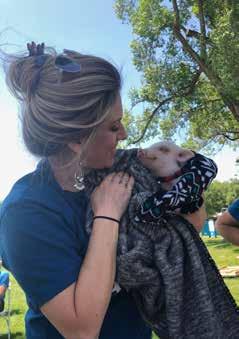
nutrition, toxic human foods, lifespan expectations, the truth about pet insurance, training techniques, managing pet allergies and more.
Listen on Spotify, Apple Podcasts, Pandora, Google Podcasts, or at www.
hollycurby.com. Bringing a pet home is a beautiful decision—but only when done thoughtfully. With the right preparation, you and your new friend can enjoy a rewarding bond that lasts a lifetime.















By Cassie Goff | c.goff@mycityjournals.com
Do you know where the closest veterinarian is to you right now? Or how you’d get your pet there? Sometimes, getting our non-human family members in to see the doctor can seem like a daunting task. That’s where Dr. Kate Swain has Salt Lake County residents covered. Swain is the owner and operator of Mobile Veterinary Options: a mobile veterinary service. Yes, you read that right – a vet van.
After working in two clinics for over 12 years, Dr. Swain noticed how the animals that had bad experiences in the vet’s office wouldn’t come back. When dogs and cats would get panicked on the way into the vet’s office, they’d react based on their fear instincts.
“It’s also a lot of stress on the owners,” said Swain. “It’s stressful when you know taking your pet in isn’t going to go smoothly. It makes people just stop taking their pets in.”
Dr. Swain wanted to provide better options for pet-owners as, just like with us humans, yearly exams are important for animal health.
“We are trying to get ahead of diseases,” Swain said. “If animals can get in once per year, same as with people and our yearly exams, we can catch things early with bloodwork.”
Mobile Veterinary Options travels throughout Salt Lake County to visit dogs, cats and horses outside of an office environment. During an appointment, Dr. Swain can either come into the animal’s environment or walk the animal out to the van.
“Some dogs are protective of their own space; some do better when we come to them. It’s really variable,” she said.
Swain shared how visiting the animal’s environment can help to provide

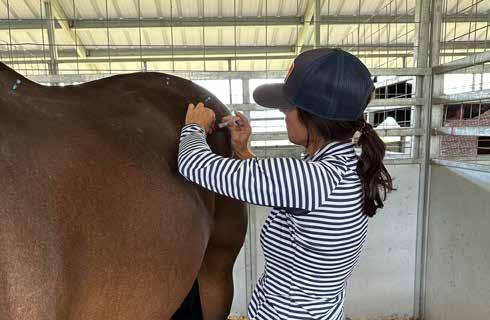
some insight into what problems may exist. For example, one of the top three issues she visits clients for is allergies. Peaking into the animal’s environment who is experiencing allergy symptoms can help her deduce if they’re suffering from food or environmental allergies.
Together with Veterinary Technician Stacie Moseley, Dr. Swain offers a variety of services for dogs, cats and horses throughout the valley. They can conduct wellness, emergency, and quality of life exams as well as mobile surgeries including dental surgeries, general surgeries and spay and neuter. They’re also equipped and prepared for home hospice and end-of-life care services including qualify of life examples, pain management and euthanasia.
“It’s just the two of us and we love it,” Swain said. “We get to go on beautiful drives. It’s, overall, so much better for

my personal wellbeing to be out.”
Moseley grew up in upstate New York and has been in the veterinary field for over 18 years. Her areas of interest include animal behavior and training, feline diseases, surgery and pain management. She is a certified dog trainer, pet sitter and gardener.
“Stacie is one of the best techs I’ve ever worked with,” Swain said. “I don’t know what I’d do if she quit. She’s irreplaceable.”
Dr. Swain studied veterinary medicine at Glasgow University for five years before returning to Utah to continue her education and career and be close to her family. Her areas of interest include surgery, dentistry, acupuncture and rescue medicine.
Mobile Veterinary Options also offers their four-legged clients options for acupuncture and laser therapy services. Acupuncture benefits include relaxation, endorphin release and response from tight muscles (especially in the backs of horses).
“Laser therapy is an option for animals who can’t have more pain medication,” Swain said. “It’s really easy to do without touching them.”
Mobile Veterinary Options has a class 4 laser that can penetrate to the bone—which can help with things like bone fractures, ear infections, and bladder stones.
Swain mentioned that chronic pain in animals is more common than many pet-owners realize. Chronic arthritis in older animals, as well as soft injury tissue in horses, is a common occurrence in their day-to-day.
“When they see their dog or cat everyday, they just don’t see that their
animal is in pain,” said Swain. “A lot of animals are living with chronic pain.”
Dr. Swain highly recommends for all residents with pets to invest in pet insurance.
“It’s super helpful for people to have pet insurance because we can do more for the animals,” she said.
In addition, Swain thinks we’re still catching up on spay and neutering, even in 2025. She would like to see more education throughout the County on spay and neuter.
Mobile Veterinary Options celebrated their two-year anniversary on Aug. 14. Dr. Swain’s and Moseley’s next big step in their business is to acquire a full body x-ray machine—which costs roughly $80,000.
Besides equipment, Dr. Swain has noticed a huge need for large animal vets in the area. About once per week, she gets a call about a goat, pig or cow and has to decline. She’s also noticing an increasing call volume for chickens.
Mobile Veterinary Options is currently traveling to take appointments throughout Salt Lake County: between West Valley and the Pointe of the Mountain. Routine check-ups and exams can be booked out for about two weeks as Swain and Mosesly plan to leave room in their daily schedules for emergency calls.
Find information and news about pet-care through their socials on Facebook and Instagram at @mobileveterinaryoptions.
To request an appointment through Mobile Veterinary Options call: 801-200-3607.
Or visit their website at: www.mobileveterinaryoptions.com.

Pet Name: Sam
Description: Sam’s the kind of cute that makes your heart melt—fluffy, soft, and effortlessly photogenic, with a blissful little smile that says he knows exactly how adorable he is. His luxurious coat and regal posture make him the definition of majestic charm.
Human: Submitted by Dani Williams

Pet Name: Nikki
Description: Nikki is a spunky lady. Always following around wherever we go, yowling for attention.
Human: Kelly Dam | Graphic Designer


Pet Name: Finn
Description: Finn loves all things snuggles and is as sassy as can be!
Human: Submitted by Mindy Martin Tamburrion

Pet Name: Dax a Doo
Description: Dax is our baby boy. We call him our BGB. Big Giant Boy. He’s a snuggle boy and best little brother to Xico.
Human: Submitted by Kristi Dancer

Pet Name: Zoya
Description: Too smart for her own good, Zoya knows a handful of tricks. Her favorites are fetch and dance – and her least favorite is stay. If she could do anything for a day, it would be chasing squirrels and birds with no idea what she would do if she caught either. Zoya is a 7 year old Weimaraner who loves cuddles and barking at anything.
Human: Cassie Goff | Editorial Staff
Pet Name: Bentley
Description: Now pushing 15 years young, “Crazy Boy” has long been the affectionate nickname for this four-legged whirlwind, rescued from the humane society. Named after Snowflake Bentley, the famous snowflake photographer, he clearly took his name to heart by becoming a full-time snow sprinter and part-time icicle connoisseur. He is a devout enthusiast of both the trail and the beach, never tiring of either. His superpower includes turning complete strangers into lifelong friends in less than 10 seconds. Basically, if joy had a fur coat and four paws, it’s Bentley.
Human: Julie Slama | Writer

Pet Name: Binx Katherine Wallet Crayon People Sink Andreasen
Description: Meet Binx, our very first kitty and the queen of our hearts! With her fluffy coat, tufted ears, and Maine Coon charm, she’s a mix of elegance and playfulness. She’s endlessly curious—especially about water—and never turns down a good cuddle.
Humans: Lindsay | Advertising Specialist and Emmie & Gracie

Pet Name: Luna
Description: Luna is a princess and always sits upright and proper. She loves to talk and is very loud! She is shy with strangers but cuddly with those she knows. She has opinions and will let you know!
Human: Stacey LaMont | Graphic Designer

Pet Name: Cash
Description: Cash is so loving and has a playful nature, often acting as my best friend and companion. Cash thrives on interaction with me but also loves my kids and their families. Human: Yvette Newton | Marketing Strategist
Community
By Julie Slama j.slama@mycityjournals.com
“It’shard to believe this was an old WalMart; it looks nothing like it.”
Jordan Education Foundation Executive Director Mike Haynes has toured the new Jordan Learning Center multiple times, but he still marvels at the transformation.
The 41,000-square-foot building at 3706 W. 9800 South—across from Elk Ridge Middle School—is set to open with the new school year. It will house the Childhood Development Center, Jordan Credit Center, three virtual schools and the Foundation, each section distinguished by unique color schemes.
Renovation began 10 months ago after the district purchased the former retail space and its five-acre property. According to a LoopNet listing, “The $31 million will be paid from the (Jordan school) board’s capital fund over five years, with interest-free installments of 1/5 of the total annually. This arrangement saves the district an estimated $5 million in financing costs.”
“It is an exciting new addition to Jordan School District,” Superintendent Anthony Godfrey said in a podcast, “using a cost-efficient approach to provide a growing number of essential and specialized educational services to families in a centralized location.”
The renovation cost $10.8 million, a fraction of new school construction, which ranges from $264 to $500 per square foot, said Ian Roberts, the district’s capital outlay manager.
“One good thing about this — Walmarts are big empty shells so we saved quite a bit of money by being able to renovate something that’s existing,” Dave Rostrom said, district director of facility services. “It’s been cheaper than tearing it down and rebuilding it — and we get five acres in a prime location.”
In early August, the parking lot was repaved and crews were finishing the entrance, which now features wood-like panels and a steel canopy to provide lighting and shelter, said Scott Hansen, project manager with En-

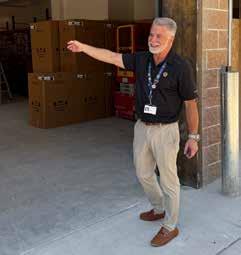
gaged Contracting.
Inside, work continued on wiring, flooring, painting and other finishes.
“We put up every single wall, did electrical, thermal work, doubled up some trusses, added a new back-up generator, cut 16 skylights, 26 rooftop (heating and air conditioning) units, did everything — security, lighting, power, fire safety – right down to the exterior walls,” Hansen said, noting collaboration with MHTN Architects.
The CDC, now relocated from Kauri Sue Hamilton School, offers early intervention and preschool for students with special needs. Located on the west side of the building, it includes several large classrooms, office space, nursing stations, dedicated testing facilities and a fenced outdoor play area.
“The program itself is exploding so this will give them a dedicated space and free up some space at Kauri Sue,” Rostrom said.
Near the CDC is the Foundation’s office, featuring fluted wood walls, workstations and a conference room. But Haynes is especially excited about the new warehouse at the north end.
“We’ve never had the ability to have a central drop off/pick up warehouse that we could store items,” he said. “Right now, we’re scattered in six different places throughout the

district. This is going to be so much nicer to have a centrally located building off of Bangerter and 9800 South.”
The warehouse includes ceiling-height shelving, a dock door and a donation pullthrough entrance.
“Last year, on National Day of Service at West Jordan High School, we had 50 cars lined up to drop off food packs and they occupied all these rooms at the high school. The problem was we didn’t have a way to get them out of the high school and we didn’t have anywhere to put the donations,” he said.
The Foundation has previously turned away donations due to lack of space, even scrambling to store $1 million in toys last year before the holidays. The new space not only has storage, but it will allow for assembly of items and student volunteer work.
“We often have groups come and assemble food backpacks or other essentials for our students and now that we’re across from Elk Ridge Middle School, it will provide the students there a convenient way to volunteer to give service,” he said.
At the center of the building is a flexible multi-purpose room with expandable partitions, large screens and floor plug-ins.
“This is a treasure; it’s hard to find a large space available in the district’s buildings,”
Haynes said.
Hansen added the room can be configured in multiple ways for meetings, luncheons or trainings.
To the east are classrooms and a science lab for virtual schools—Rocky Peak Elementary, Kelsey Peak Middle and Kings Peak High—which host in-person sessions for art, STEM and field trips.
“This is going to make a difference with virtual schools,” Haynes said. “It’s something a student can be proud about to be a part of it. It’s so much different than working out of a portable or a shared school.”
Nearby are rooms for coaches, teachers and an employee break room. Much of the area has skylights and fabric-like architectural baffles which manage air, sound and light, Engage said.
In the southeast corner is the Jordan Credit Center, which offers students options such as competency tests, grade replacement and credit recovery to help them graduate.
Haynes believes the new center delivers on its promise: “This space is beautiful and will accommodate and support the needs of our students, programs, schools and community.” l


























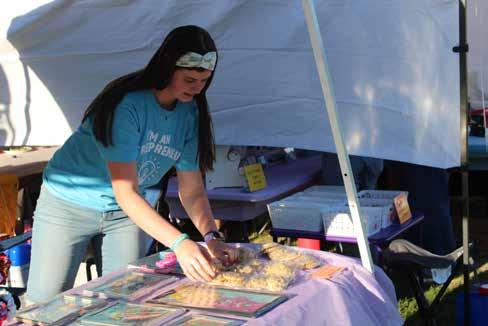























The Mountain Ridge boys golf team has no shortage of capable players this season. The sentinels enjoy strong leaders who are examples on and off the course.
By Josh McFadden j.mcfadden@mycityjournals.com
Perhapsmore so than any other sport, golf requires excellent mental toughness. It’s a sport where teams need leaders to encourage and lift teammates who are struggling. Fortunately for the Mountain Ridge boys golf team, finding these examples of leadership shouldn’t be a problem.
The Sentinels have a large team that includes seasoned veterans combined with some younger players who are eager to prove themselves and contribute to the team’s success. A good chunk of the players on the squad are seniors, something that head coach Ryan Avila believes will pay dividends this season.
“Our biggest strength is our leadership,” Avila said. “We’ve got a big senior class that will set the tone for the rest of the team. We’ve also got a deeper team than we’ve ever had, with everyone ready to compete for varsity spots.”
The varsity squad includes nine seniors, each of whom is excited for the season and eager to lead with their play, work ethic and
attitude. Those seniors are Kooper Ashauer, Reagan Bailey, Gavin Chazen, Goen Gibby, Cooper Jones, Jake Lavender, Tyson Rich, Alex Terrion and Nate Vance.
“They are all returning players and will be the glue that holds the team together,” Avila said.
The junior class is strong too, and there are solid performers and good leaders in that group as well. Avila is excited to see what these 11th graders—Carter Camp, Jaxon Hunt, Tag Natter, Breken Ross and Kason Shields—will do to complement their senior counterparts.
“They will all have big roles to fill this year,” Avila said of the juniors.
A quartet of sophomores—Connor Cantwell, Tag Ihler, Korver Kay and Tyce Olson— could be contributors this season as well. Avila is intrigued with freshmen Bridger Blood, Jake Bowen and Miles Vance.
“[The freshmen] will all be learning the ropes and keeping the seniors on their toes as they start their freshman seasons,” Avila said.
As the season has gotten underway, Avila has been impressed with the players’ desire to improve and compete at a high level. He also likes how they are getting along and establishing good camaraderie and team culture. He said the boys like to have fun but know when it’s time to get to work.
“We are very excited to start this season,” Avila said. “The guys have come into this season ready to work hard and compete with each
other while also being extremely supportive of one another. Everyone is serious when it comes to producing, but they joke and enjoy the atmosphere when it’s over.”
Region 2 won’t be a cakewalk by any stretch of the imagination. Avila knows his team will have to be at its best at each tournament if it wants to achieve its goals and be successful. In Region 2, the Sentinels will go up against previous league opponents Bingham, Herriman, Copper Hills and Riverton. New region teams Westlake and Cedar Valley offer unfamiliar challenges.
Avila has high expectations for the season despite the formidable opposition.
“We expect to be competitive with the top of our region and get better every week,” he said. “The goal is to be at our best when the state tournament arrives and to make the cut as a team at state.”
In golf, the most successful teams are deep and have a lot of players make the cut at tournaments. Avila knows that every member of the team will have to do his part for the Sentinels to be among the top squads in the region. Mountain Ridge may not have a lot of stars, but there are plenty of golfers who can help the team lower its overall score.
“It’s going to take everyone on the team getting better and better every day,” Avila said. “We will not be able to rely on one or two individuals this year; it will take a group effort.”
In some ways, the large number of play-

ers that Avila can turn to presents some challenges for Mountain Ridge. Avila is eager to see who emerges to become the top players on the team.
“It will be tough for me to choose the best lineup every tournament,” he said. “Each tournament has only eight varsity spots, but we’ve got 21 guys that are all very competitive with the potential to go low. We are excited, though, for the guys to rise to the occasion under the added pressure.”
With the mental aspect of golf being so critical, Avila said he will spend a lot of time making sure the players have the right mindset. He believes this focus will lead to better golfing and the results that the team wants.
“Our mental toughness will be a point of emphasis this season,” he said. “Our team has plenty of skill, but on the golf course, so much of the game is mental. Improving our mental strength will be a key to playing well.”
Because of the great leadership the Sentinels have, Avila said his job is easy and it’s enjoyable. He is impressed each day with the caliber of people he coaches.
“I love watching [the players] do the right things without needing to be told to,” he said. “These kids are incredibly responsible and accountable for their actions. They treat each other and those around them with respect, play by the rules with a positive attitude and take on leadership roles when they present themselves.”l








As Riverton continues to grow, so do the transportation challenges that affect all of us, whether you’re driving to work on 134th South, walking your kids to school down Morning Cloak Way, or simply trying to enjoy a Saturday afternoon in our beautiful city. My colleagues and I on the city council hear your concerns about traffic congestion, road safety, and the ease of getting around town, and I want you to know we are listening and taking action.
The Southwest corner of Salt Lake County’s booming population growth brings with it increased demands on our city’s infrastructure. Some of our streets were not built for the traffic volumes we’re now seeing on a daily basis, and at the rate neighboring cities around us are growing, traffic problems will only get worse if left unaddressed. That’s why I have worked hard to develop relationships with regional transportation partners and support all efforts to implement targeted solutions, like improving traffic signal timing, upgrading key intersections, and planning for infrastructure that anticipates our city’s future needs, not just today’s.
Public safety is one of the core purpos-

es of local government and as such, it is my number one priority as a city councilman. Every resident should feel safe whether they’re behind the wheel, riding a bike, or walking through their neighborhood. That’s why I’m advocating for more stop signs near schools and parks, better lighting in high-traffic zones, and stronger enforcement of speed limits in residential areas. These changes are not cosmetic, they save lives.
Making Riverton Easier to Navigate
We need to make it simpler for people to move through our city. Clearer road signage, smarter route planning for commuters, and improved access to public transit are all on the table. I’m also a staunch supporter of expanding options for pedestrians and cyclists by improving and adding walking and biking paths.
Let’s Build a Better Riverton Together
A well-connected, safe, and efficient transportation system is vital to our city’s quality of life. I am committed to building that future along with my colleagues on the city council, but we can’t do it alone. Your feedback is crucial, and I welcome your ideas and concerns.
Let’s work together to make Riverton a city that moves with purpose and safety, for everyone.








It’sbarely September and social media pages are already flooded with autumn recipes, pumpkin hacks and tips on how to dress for sweater weather. For Utah, sweater weather in September is just dumb because it’s still 90 degrees in the shade. Wear a cute, fall pullover at your own risk.
Instagram influencers suffer from September insanity, bizarrely excited to roam through corn mazes (nature’s escape room), decorate porches with scratchy hay bales and crooked scarecrows, and stage family photo shoots at apple orchards with everyone grumpily dressed in red and black flannel.
In September, you’re legally required to wear a wool scarf when ordering at Starbucks, where each drink has a dash of cinnamon. Pumpkin spice is everywhere, from pancakes to deodorant, popping up out of nowhere like political yard signs and herpes.
These aren’t necessarily bad things. I love me a plaid shirt and fresh-baked apple crisp, but until Monday, Sept. 22, at 12:19 p.m. (MDT), it’s still summer and I will behave accordingly.
Here’s what shouldn’t happen before Sept 22: high school sports, pumpkin patches, hay rides, the NFL. None of those are summer activities. Nada.
Even if the temperature drops to 45 degrees by mid-September (which it won’t), I’ll still wear flip-flops and gym shorts as

my casual work outfit. Well, flip-flops only if I’m going somewhere fancy, like Dollar Tree. I might as well not own shoes during the summer.
After going barefoot since April, my feet have reached the hardened leather stage where I could safely walk across a lava flow. My granddaughter recently poked my heel and asked, “What happened to you?” I tried to explain the development of callouses due to traversing 110-degree asphalt with no shoes, but she’d already turned her attention back to Roblox.
Even Mother Nature betrays me as the Wasatch Mountains start to turn a brilliant red, orange and gold. Sunset gets earlier each night, disappearing a little bit at a time, like when I’m trying to sneak out of a networking event. The air takes on a distinctly “autumn” glow, but that might be arsenic floating over from the Great Salt Lake. Living in Utah is exciting.
Farmers’ markets are still open, but

the options quickly turn from juicy, sweet peaches to…umm…squash? Who eats squash? Raccoons? Hardened criminals? I use pumpkin for cookies, bread and carving, but no one actually EATS pumpkin. That’s like saying someone actually eats rhubarb. I don’t have time for your nonsense.
One good thing about September is that Michaels no longer sells Halloween items (which they started promoting in May) but is now decked out for Christmas.
Believe it or not, I love fall, but only when seasonally appropriate. Summer flies by, so I must savor every sunny moment before Salt Lake sinks into six months of cold,
gray darkness, like Persephone descending to the Underworld.
On the first day of autumn (Sept. 22, not Sept. 1), I’ll drape fall garlands around the kitchen, light apple-scented candles, put on cozy socks (an easy transition from being barefoot) and make a big pot of stew that no one will eat because it has onions.
Within a few weeks, my social media pages will display photos of squirrels gathering nuts, my grandkids bickering at a harvest festival, Tom refusing to eat apple cider donuts and my fire-orange pedicure hidden inside a cute pair of fall boots. But only in appropriate autumnal timing.








